Taheyya Kariokka
Taheyya Kariokka (Arabic: تحية كاريوكا) also Tahiya Carioca (born Badaweya Mohamed Kareem Ali elnedany), (February 22, 1915[lower-alpha 1] – September 20, 1999) was an Egyptian belly dancer and film actress.[1][2][3]
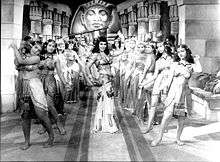
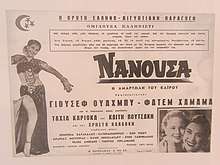
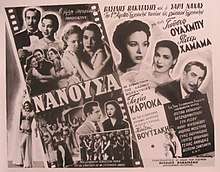
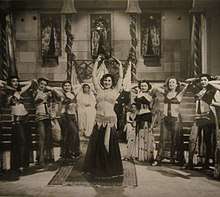
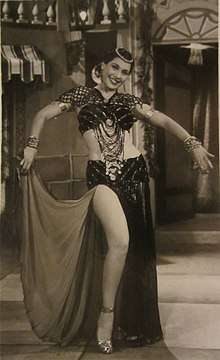
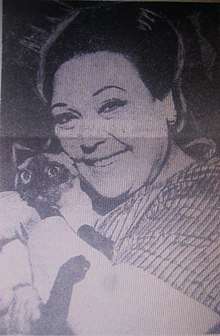
Early life
Born in the Egyptian town of Ismaïlia to Mohamed Ali and Fatma Elzharaa. Her father was a boat merchant who had married 6 times. It is said that Badawiya's father was around 60 years old during the time her mother was in her early twenties.[4][5] Badawiya was barely able to speak when her father died. After the death of her father, Badaweya was sent to live with her older half-brother Ahmed Ali Elnedany. While there she was tortured, treated like a slave and locked in chains. Every time she tried to escape he would find her and torture her even more, till one day he shaved her hair.[6][7]
Career
With the help of her nephew Osman Elnedany, she escaped to Cairo to stay with Souad Mahasen, a night club owner and an artist. Tahiya had asked several times for employment in Suad's nightclub but Suad refused to employ her due to the disreputability of working at a nightclub. However, many of Suad's associates and friends became acquainted with Tahiya through various visits to Suad's home. They all advised Suad to add her to one of the shows as a chorus girl but still she refused. Soon, Tahiya was mentioned to Badia Masabni, the owner of Casino Opera, one of the most prominent nightclubs of the time. Badia offered a position in her troupe to Tahiya. Tahiya accepted and was given the stage name Tahiya Mohamed. She soon began gaining popularity as a solo dancer and as she became more experienced she learned a popular Samba dance from Brazil at the time called the Carioca. After that she became known as Tahiya Carioca. Tahiya began starring in movies during what is dubbed as the Egyptian film industry's "Golden Age". She was a talented dancer, singer, and actress. In 1972, the film “Watch out for Zouzou”, starring Soad Hosni with Tahiya performing the supporting role, was released to become the biggest box-office hit in Egyptian cinema to date.[8][9]
Personal life
Tahiya was married 17 times; among her husbands were actor Rushdy Abaza and playwright Fayez Halawa. Tahiya was unable to conceive any children of her own and hence adopted a daughter (Atiyat Allah). Tahiya also was very involved with her sibling's children. Tahiya later moved to London.
Tahyia died of a heart attack on September 20, 1999, aged 84.
Filmography
- Mercedes (1993)
- Iskanderiya, kaman wi kaman (Alexandria Again and Forever) (1990)
- Weda'an Bonapart (Goodbye Bonaparte) (1985)
- Saqqa mat, al- (The Water-Carrier Is Dead) (Film, 1977)
- Tareek, al- (The Road) (1964)
- Imm el aroussa (Mother of the Bride) (1963)
- Shabab Emraa (A Woman's Youth), also known as The Leech (1956)
- Rommel's Treasure (1955)
- Hira wa chebab Ana zanbi eh? (Is It My Fault?) (1953)
- Ibn al ajar (A Child for Rent) (1953)
- Muntasir, El (The Conqueror) (1952)
- Omm el katila, El (The Criminal Mother) (1952)
- Zuhur el fatina, El (The Charming Flowers) (1952)
- Feiruz hanem (Mrs. Feiruz) (1951)
- Ibn el halal (The True-born Son) (1951)
- Khadaini abi (My Father Deceived Me) (1951)
- Akbal el bakari (A Large Family) (1950)
- Ayni bi-triff (My Eye Is Winking) (1950)
- Aheb el raks (I Like Dancing) (1949)
- Amirat el djezira (The Princess of the Island) (1949)
- Katel, El (The Murderer) (1949)
- Mandeel al helu (The Beauty's Veil) (1949)
- Hub wa junun (Love and Madness) (1948)
- Ibn el fellah (The Peasant's Son) (1948)
- Yahia el fann (Long Live Art) (1948)
- Li'bat al sitt (The Lady's Puppet) (1946)
- Ma akdarshi (I Can't Do It) (1946)
- Najaf (1946)
- Sabr tayeb, El (Have Patience) (1946)
- Aheb el baladi (I Like Home Cooking) (1945)
- Hub El awal, El (First Love) (1945)
- Lailat el jumaa (Friday Evening) (1945)
- Naduga (1944)
- Rabiha-takiet el ekhfaa (The Magic Hat) (1944)
- Taqiyyat al ikhfa (1944)
- Ahlam El shabab (Dreams of Youth) (1943)
- Ahib Al ghalat (I Like Mistakes) (1942)
See also
Notes
- Her year of birth was 1915 according to author Barbara Sellers-Young, 1919 according to the Encyclopedia Britannica, and 1920 according to her New York Times obituary.
References
- Sellers-Young, Barbara (2016). Belly Dance, Pilgrimage and Identity. Springer. p. 26. ISBN 9781349949540.
- Martin, Douglas (22 September 1999). "Tahia Carioca, 79, Dies; A Renowned Belly Dancer". The New York Times.
- "Tahia Carioca - Egyptian actor and dancer". Encyclopedia Britannica. 15 February 2018. Retrieved 27 March 2018.
- "شاهد رجاء الجداوي تفجر مفاجأة عن علاقتها هيّ وخالتها الراقصة تحية كاريوكا بالسعودية.. وتكشف عن اسمها الحقيقي".
- @majmoutinsaan (4 June 2019). "ذكريات رجاء الجداوي في السعودية والإمارات" (Tweet) (in Arabic) – via Twitter.
- "شقيقها عذبها وربطها في السرير.. محطات في حياة تحية كاريوكا". مصراوي.كوم. Retrieved 2020-07-07.
- "من مذكراتها.. حافية وشعرها "محلوق".. قصة هروب تحية كاريوكا من أهلها فى الإسماعيلية لتعمل راقصة فى شارع عماد الدين.. من ساعدها فى "الهروب الكبير".. ومن هى الفنانة "سعاد محاسن"؟". اليوم السابع. 2019-02-11. Retrieved 2020-07-07.
- , Al-Ahram Weekly Online, 28 June - 4 July 2001, Issue No.540, “Before the public gaze” by Mona Anis
- , Articles on Soad Hosni, her sister Najat Al Saghira and her father the calligrapher